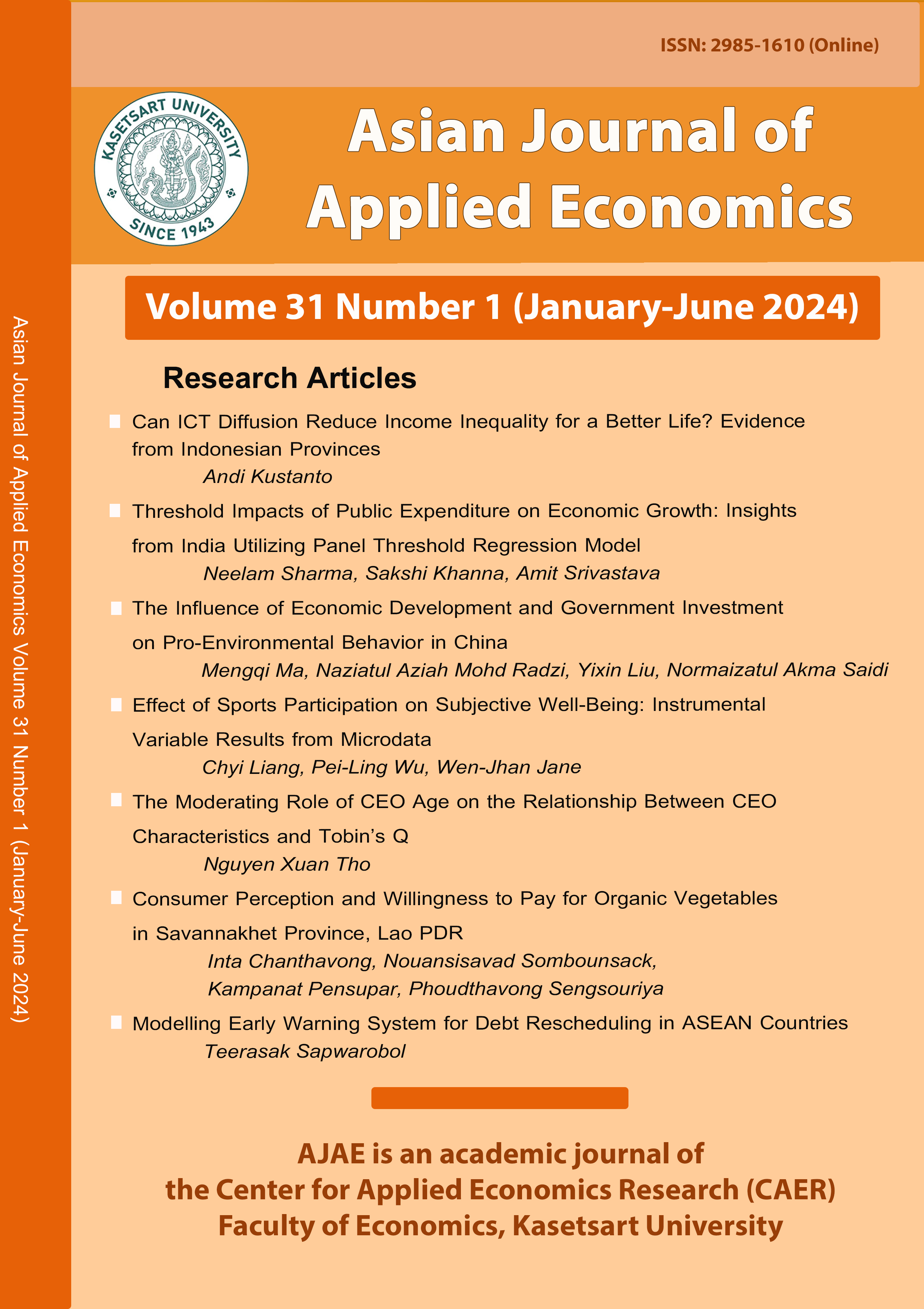Consumer Perception and Willingness to Pay for Organic Vegetables in Savannakhet Province, Lao PDR
Main Article Content
บทคัดย่อ
Organic vegetables play a vital role in reducing exposure to harmful substances in food. This study aimed to assess consumer perceptions and willingness to pay (WTP) for organic vegetables, and identify factors influencing respondents' WTP for such vegetables in Savannakhet province, Lao PDR. A total of 368 respondents participated, with data collected using a structured questionnaire. Descriptive statistics, contingent valuation method, and logit models were employed for analysis. Results indicated that 60.30% of tested fresh vegetables were free from chemical contamination and toxins. High and moderate levels of chemical contamination were observed in only 6.25% and 25% of fresh vegetables, respectively. Approximately 35.29% of consumers reported regular weekly purchases of organic vegetables, with an average consumption of 3.78±2.45 kg/week, priced between 0.37 USD and 3.09 USD. Organic vegetables were favored for their perceived health benefits and quality, with 98.53% of consumers expressing future demand. The mean WTP for organic vegetables was found to be 1.14 USD per 1 kg. Bid premiums negatively impacted WTP for lettuce, glory, and mints products, while occupation exhibited a negative correlation with WTP for Chinese cabbage and onion.
Article Details

อนุญาตภายใต้เงื่อนไข Creative Commons Attribution-NonCommercial-NoDerivatives 4.0 International License.
The paper is published under CC BY-NC-ND, in which the article is freely downloaded and shared in its original form non-commercially and its citation details are identified.
เอกสารอ้างอิง
Anil, M., & Sununtar, S. (2008). Organic crops or energy crops? Options for rural development in Cambodia and the Lao People’s Democratic Republic (ADB Institute Discussion Paper No. 101). Tokyo: Asian Development Bank Institute.
Ayaviri-Nina V. D., Jaramillo-Quinzo N. S., Quispe-Fernández, G. M., Mahmud, I., Alasqah, I., Alharbi T. A. F., Alqarawi, N., Carrascosa, C., Saraiva, A., Alfheeaid, H. A., & Raposo, A. (2022). Consumer behaviour and attitude towards the purchase of organic products in Riobamba, Ecuador. Foods, 11(18), 2849.
Bartlett, J. E., Kotrlik, J. W., & Higgins, C. C. (2001). Organizational research: Determining appropriate sample size in survey research. Information Technology, Learning and Performance Journal, 19, 43-50.
Bhattarai, K. (2019). Consumers’ willingness to pay for organic vegetables: Empirical evidence from Nepal. Economics and Sociology, 12(3), 132-146.
Caswell, J. A. (2003). Trends in food safety standards and regulation implications for developing countries (2020 vision briefs 10 No. 4). International Food Policy Research Institute (IFPRI).
Deus, A.M. (2009). US college student perceptions of organic food products and buying habits. San Luis Obispo: Agriculture Education and Communication Department, California Polytechnic State University.
Griffith, R., & Nesheim, L. (2008). Household willingness to pay for organic products. London: Institute for Fiscal Studies.
Mishra, B., & Prusty, A. K. (2016). Consumer’ perception on pesticide residues in fruits and vegetables. International Journal of Bio-resource, Environment and Agricultural Sciences, 2(4), 426-429.
Ngigi, M. W., Okello, J. J., Lagerkvist, C. L., Karanja, N. K., & Mburu, J. (2011). Urban consumers’ willingness to pay for quality of leafy vegetables along the value chain: The case of Nairobi kale consumers, Kenya. International Journal of Business and Social Science, 2(7), 208-216.
Obayelu, O. A., Agboyinu, O. M., & Awotide, B. A. (2014). Consumers’ perception and willingness to pay for organic leafy vegetables in Uurban Oyo State, Nigeria. European Journal of Nutrition & Food Safety, 4(2), 127-136.
Owusu, V., & Anifori, M. O. (2013). Consumer willingness to pay a premium for organic fruit and vegetable in Ghana. International Food and Agribusiness Management Review, 16(1), 67-86.
Pandit, J., Regmi, P. P., Paudel, B., Karki, Y. K., & K. C., G. B. (2022). Factors affecting willingness to par for organic vegetables in Nepal. Socio Economy and Policy Studies (SEPS), 2(2), 44-52.
Phillip, B., & Dipeolu, A. O. (2010). Willingness to pay for organic vegetables in Abeokuta, South West Nigeria. African Journal of Food, Agriculture, Nutrition and Development, 10(11), 4364-4378.
Policy Department, Directorate-General for External Policies. (2021). The use of pesticides in developing countries and their impact on health and the right to food. Brussels: European Union.
Rungsrisawat, S. (2014). An evaluation of buying behaviors and perceptions of organic vegetable consumers in Chiang Mai province. International scholarly and scientific research and innovation, 8(9), 3090-3094.
Sonethavixay, S. (2019). Five ways to boost innovation in organic vegetable production (Policy Brief No. 001/2019/CDAIS). Vientiane: Policy Think Tank, National Agriculture and Forestry Research Institute.
The Norwegian Scientific Committee for Food Safety. (2014). Comparison of organic and conventional food and food production. Overall summary: Impact on plant health, animal health and welfare, and human health. VKM Report.
Wee, C. S., Ariff, M. S. B. M., Zakuan, N., Tajudin, M. N. M., Ismail, K., & Ishak, N. (2014). Consumers perception, purchase intention and actual purchase behavior of organic food products. Review of Integrative Business and Economics Research, 3(2), 378-397.
Wojciechowska-Solis, S. J., & Barska, A. (2021). Exploring the preferences of consumers’ organic products in aspects of sustainable Consumption: The Case of the Polish Consumer. Agriculture, 11(2), 138.


